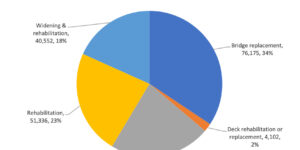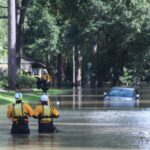Flood is the most pervasive and frequent peril in the U.S. Yet, despite having the world’s highest non-life premium volume and one of the highest insurance penetration rates, a significant protection gap still exists in the U.S. for this peril.
Executive Summary
As the journey toward a private flood insurance market progresses, insurers and reinsurers can learn a lot from the recent U.S. flood events to help develop profitable flood risk management strategies.It is well-known that U.S. flood risk is primarily driven by tropical cyclone-related events, with storm surge being the main cause. In the last decade alone, flooding from tropical cyclones have caused more than $40 billion (2015 USD) in insured losses and contributed to today’s massive $23 billion National Flood Insurance Program (NFIP) deficit: 13 out of the top 15 flood events, determined by total NFIP payouts, were related to storm surge-driven coastal flooding from tropical cyclones.
Inland flooding, however, should not be overlooked. It can contribute to a material portion of overall U.S. flood risk, as seen recently in the Southern Gulf, South Carolina and in West Virginia (described below). These catastrophes caused billions in economic and insured losses while demonstrating the widespread impact caused by precipitation-driven fluvial (riverine) or pluvial (surface water) flooding. These types of flooding events should be accounted for and well understood by insurers and reinsurers looking to enter the private flood insurance market.
It Hasn’t Just Rained; It’s Poured
In the past 15 months, the U.S. has suffered several record-breaking or significant rainfall-induced inland flood events.
In May 2015, Texas experienced its wettest month on record, causing widespread flooding across the state and damaging more than 5,000 properties, most of which were residential and located in metro regions of Houston, Austin and Dallas. Although several counties were declared disaster areas and thus received federal relief money, the flooding has since become the second-costliest NFIP flood event not affiliated with a tropical cyclone.
In October 2015, a complex weather system brought consecutive days of torrential rain to South Carolina, causing widespread damage to properties, automobiles and public infrastructure. It caused well over a billion dollars in economic losses and hundreds of millions in insured losses, making it one of the top five U.S. natural catastrophes of 2015.
In March of this year, record flooding impacted the Southern Gulf. More than 20 inches of rain fell over a seven-day period in Louisiana, Mississippi and parts of Texas, causing flash and riverine flooding and damaging more than 13,000 properties. In April, extremely heavy rainfall hit parts of Southern Texas, causing widespread pluvial flooding. Precipitation-induced flooding impacted the region again in May and June, the already saturated soil conditions exacerbating the severity of the floods. At the same time, West Virginia suffered record-breaking rainfall totals that caused devastating flash floods after parts of the state received up to 10 inches of rain over the course of a few hours. The 24-hour rainfall totals were reported to be the worst in a century.
Learning From Recent Events
Today, the majority of flood coverage exists through the NFIP, but momentum is building toward more private-market involvement: Legislation is being passed at the federal and state level to make it easier for private insurers to write flood insurance; rates are slowly rising to reflect a more actuarially sound risk profile; and flood modeling has advanced to the point where discerning location-level flood risk is now possible.
It may take time before the private flood market is well-established, but those (re)insurers that are considering developing or growing a flood portfolio should make every effort to learn from the recent U.S. flood events, namely:
1. A complete view of flood hazard = pluvial + fluvial + coastal
Flood risk is driven by several sources. Many of the recent big loss-driving inland floods were driven by both fluvial and pluvial flooding. Failure to account for both components could result in a significantly underestimated view of inland flood hazard, potentially leading to “surprise” losses, unfavorable risk selection or poor underwriting guidelines. Having a complete view of flood hazard is one that reflects all sources and extents of coastal and inland flooding.
2. Inland flood hazard is dynamic
Recent flood events have underscored the very dynamic nature of U.S. inland flooding, something that is not fully reflected in the short historical record. Inland flooding can vary in time and space. It can occur across a variety of annual and sub-annual frequencies, last on timescales of hours to weeks, and impact a wide range of spatial extents—from single catchments or cities to entire river basins across multiple states.
It is also a peril that can be impacted dramatically by antecedent conditions. Two precipitation events with similar intensity and duration characteristics can yield two completely different outcomes depending on how saturated the soils are before the onset of the event.
Further, the U.S. inland flood landscape is constantly being shaped and reshaped by a number of geographical and manmade changes. For instance, exposure and population growth generally leads to more water-impermeable surfaces, such as roads or parking lots, which can dramatically increase the flood-hazard profile of nearby structures. This was the case during the Houston floods, where significant property and population growth over the last 15-20 years has made the city more prone to flash flooding during intense precipitation events.
Know Your Flood Defenses
Flood defenses and levees can also have a major impact on flood extent, depth and overall resilience for many homes and businesses. Understanding whether a location is protected by defenses or levees, and what the corresponding standards of protection are, can help carriers to accurately estimate flood-hazard susceptibility and to avoid improper exclusion (or inclusion) during the risk selection process.
The aforementioned events offer valuable insights into inland flood hazard, which can help inform more effective flood risk management as a whole. A view of flood hazard should reflect how flood is spatially and temporally correlated across all its major sources, coastal and inland, within and across regions. It should reflect events, conditions and scenarios that go beyond what is captured in the historical record and reflect the impacts of flood mitigation efforts. Granted, having a complete view of flood hazard only provides one part of the risk picture, but by striving to attain this view, at a minimum, firms will be in a stronger position to inform more effective flood risk differentiation, selection and overall portfolio management.




















 Florida Home Sales Decline Amid Hurricane Recovery, Surging HOA and Insurance Costs
Florida Home Sales Decline Amid Hurricane Recovery, Surging HOA and Insurance Costs  Mitigating Flood Risk 10x More Cost Effective Than Rebuilding: Swiss Re
Mitigating Flood Risk 10x More Cost Effective Than Rebuilding: Swiss Re  Hurricanes Helene, Milton Pressure NFIP; Expected Loss Ratio 200%
Hurricanes Helene, Milton Pressure NFIP; Expected Loss Ratio 200%  More Than Half of All Employees in Finance, Insurance Work Remotely: Triple-I
More Than Half of All Employees in Finance, Insurance Work Remotely: Triple-I 






